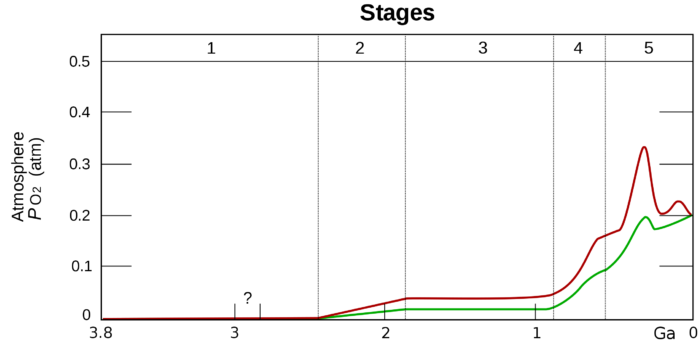Apr 05 2021
The Great Oxygenation Events
 The deep history of the Earth is fascinating, and while we have learned much about the distant past there are still many puzzle pieces missing. A new study tweaks our understanding of one of the biggest events in Earth’s history – the Great Oxygenation Event, and also helps better align the other big events in the past.
The deep history of the Earth is fascinating, and while we have learned much about the distant past there are still many puzzle pieces missing. A new study tweaks our understanding of one of the biggest events in Earth’s history – the Great Oxygenation Event, and also helps better align the other big events in the past.
The Earth as we know it formed about 4.5 billion years ago. Earth is actually Earth 2.0 – the proto-Earth was hit by a Mars-sized object, forming both the current Earth and the Moon. The Earth was fairly molten at this time, still hot from all the impacts, but over the next millions of years the surface cooled, stable pools of liquid water formed on the surface, and it had a stable atmosphere of mostly nitrogen. In this environment life evolved. We are not exactly sure when, but probably by 3.5 billion years ago. There is good evidence for cyanobacteria by 2.9 billion years ago. These critters are important, because they make food from sunlight and produce oxygen as a waste byproduct. For millions of years oceans full of cyanobacteria cranked out oxygen, which built up in the atmosphere.
This is where the new study comes in – it explores exactly when oxygen built up to high levels. The current atmosphere is about 78% nitrogen, 21% oxygen, 0.04% carbon dioxide, and trace amounts of methane and other gases. Prior to about 2.45 billion years ago there was essentially zero oxygen in the atmosphere. Between 2.45 and 1.85 billion years ago oxygen built up slowly in the atmosphere, up to 3-5%, but was also mostly absorbed by the oceans and seabed rock. This is the Great Oxygenation Event, still little oxygen by today’s standard, but enough to usher in a major change in the chemistry of earth. From 1.85 to 0.85 billion years ago oxygen had saturated the ocean and so now spread to the land where it was further absorbed into rocks and minerals. During this time atmospheric O2 levels were pretty stable at 3-5%. But then, starting 0.85 billion years ago the surface of the Earth had absorbed all the oxygen it could (the oxygen sinks were full) and so O2 started building up in the atmosphere significantly, peaking about 400 million years ago at over 30% and then settling down to the current 21%. Oxygen levels are now slowly and steadily decreasing.
Let’s get back to the 2.45 billion years ago when oxygen levels started to rise. It was previously thought that once oxygen started to rise, this process was stable and continuous. But the new study suggests that the early period of oxygenation was unstable, with oxygen levels crashing multiple times. Oxygenation did not become stable until 100 million years later than previously thought. This has implications for another aspect of Earth’s history – global temperatures. Around this same time there were four episodes of “Snowball Earth” – periods of planet-wide glaciation with the entire surface of the Earth covered in snow and ice, including the oceans, each lasting millions of years. It is thought that these episodes occurred because of the rise of oxygen. This changed the atmosphere’s chemistry, decreasing CO2 and methane, critical greenhouse gases. This decrease pushed the Earth into a cooling spiral until – Snowball Earth. The planet did not emerge from each of these glaciation periods until there was sufficient outgassing of more CO2 from volcanoes.
This is where the new study solves a prior mystery. It was initially thought that there was one oxygenation event, which would have triggered a Snowball Earth, but then why were there four glaciation periods? The new data suggests that there were multiple oxygenation events, probably triggering the multiple glaciation events, until oxygenation finally became permanent. The timing now fits better, aligning the oxygenation events and the glaciation events.
But now there is the deeper question – what caused the fluctuating oxygenation events? The most likely answer is the cause of oxygenation in the first place, life. Cyanobacteria formed oxygen, but in so doing made the environment toxic to themselves. They also plunged their own world into a deep freeze. This may have triggered a mass extinction, allowing CO2 to build back up and thaw the Earth, followed by another oxygenation event and another freeze. This cycle repeated four times, before finally stabilizing.
What was different the last time, however? Perhaps volcanic CO2 levels finally built up enough to avoid a glaciation event despite increasing oxygen. But perhaps the answer again is life. After this period of fluctuation there was a billion years of stability, with atmospheric O2 at 3-5% and a stable climate. Perhaps life at this time was also in equilibrium. Organisms were making oxygen, but perhaps others were eating them, breathing oxygen, and producing CO2. It’s hard to say because there was still an excess of oxygen being created, and absorbed by land sinks. This is also all before evidence of multi-cellular life. The Cambrian explosion did not occur until about 300 million years after oxygen level started increasing again, getting to near present levels. Perhaps the pre-Cambrian Ediacaran fauna was at work (multi-cellular life that may or may not have evolved into Cambrian life).
There are still lots of questions remaining. But what we are clearly seeing is an interaction among life biochemistry, geologic and atmospheric chemistry, and climate. These are long term trends playing out over millions of years at least, and sometimes billions of years. But the picture of Earth’s deep history has clicked into focus just a little bit more.






